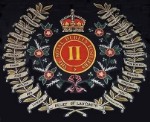Catalan Bay
[Molly Bloom, thinking of Gibraltar.] "... the smell of the sea excited me of course the sardines and the bream in Catalan bay round the back of the rock they were fine all silver in the fishermens baskets old Luigi near a hundred they said came from Genoa and the tall old chap with the earrings ..."
n/ Ulysses (Gabler) 18:973-76.
In the late-nineteenth century, this part of Gibraltar had no connection with Catalonia, nor were any Catalans living there. It was a fishing village inhabited by descendants of seasonal Genoese fishermen. There was also a detachment of soldiers always quartered there. Behind the barracks was a small Catholic church.
"The village is well worth a visit, as the Rock nowhere looks more grand and imposing than the steeps which rise almost perpendicularly behind it. These occasionally remind the villagers of their close proximity in a manner no less practical than dangerous, by tumbling big stones down upon their dwellings, which has sometimes occasioned not a few disasters. During the French invasion [of Spain by Napoleon] many of the inhabitants of San Roque who had sought refuge at Catalan Bay, were victims of a large fall of stone from the cliffs. In 1870 there was a very large landslip, but fortunately on the road near the North Front, so the village escaped; the road was however destroyed, but as the fall happened in the night no lives were lost. In the flood of November 1875, the little church was completely gutted by the torrent of sand and stones washed from the rocks above, and some of the out-buildings of the barracks were buried, but there were no casualties."
The village passed, a path over the sand leads to the next bay (Sandy Bay), from which no further progress can be made."
n/ George James Gilbard, Gibraltar Directory and Guide, 1883.
Catalan Bay, c. 1890
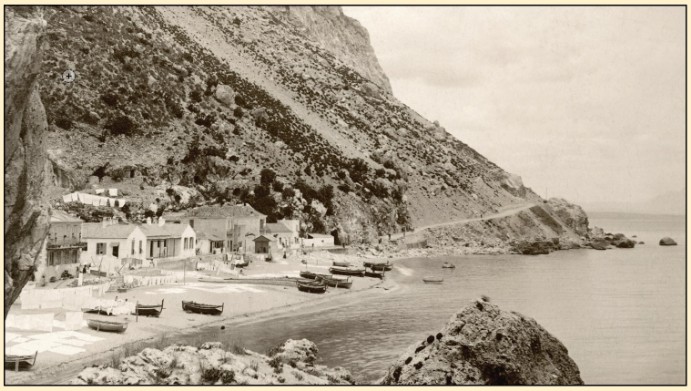
Note the "road" leaving the village which connects to the North Front.
Catalan Bay, 2020
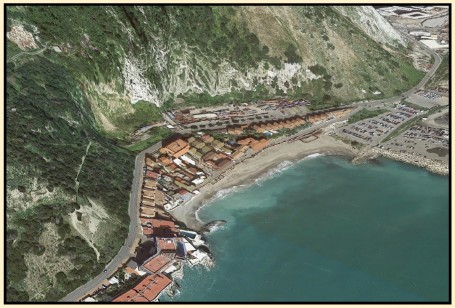
© 2021 Google Imagery, CNES/Airbus, Instituto de Cartograf, Maxar Technologies.
Note the extensive landfill and disappearance of the old, unpaved road.
Catalan Bay, Mid-19th Century
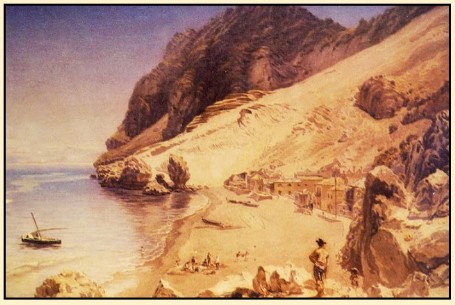
Painting by Thomas Robert Colman Dibdin (1810-1893). South view from the North Front road.
Origin of the Name
"The name Catalan Bay dates from the early 18th century. After Catalonia declared for the Archduke in 1705 allying with Britain, Catalan fishermen would likely have salted their anchovies 'Boquerones' at this beach before sending them back to Catalonia. Similarly Genoese traders and seasonal workers began to use this bay and when they migrated away from Genoa this little fishing village became predominantly a Genoese colony. Due to its relative inaccessibility from the town and the regular rock falls that blocked the route this area of Gibraltar remained largely autonomous and kept a lot of its authentic charm."
n/ Gibraltar Heritage Trust, www.gibraltarheritagetrust.org.gi.
"We are therefore able to narrow down the date of the origin of the name of the bay. It would be towards the end of the Spanish period or early in the British period. If the bay were named during the Spanish period then it would most probably refer to a settlement of some sort for which we have no evidence. Furthermore, with minor exceptions, most place names of Gibraltar from the British period bear no relation to the former Spanish name. This might indicate that the origin of the name is from the very early British period. We know that Hesse had a Catalan contingent when he landed his marines on the isthmus. Catalan Bay is not far and he may have posted the Catalan detachment there. In any case the Catalans who stayed on in Gibraltar seasonally fished on the eastern side and it is this practice that must have given the bay its name. It is clear that the settlement and the name are unrelated and that the settlement was indeed composed of a mixture of nationalities though probably established by Genoese fishermen, who may have followed the Catalan fishing practices, sometime between 1775 and 1805 (possibly between 1775 and 1783) although they may have been living there, in caves which may have been originally used by the Catalans, from at least 1748 and probably earlier. This narrow time frame for the establishment of the Catalan Bay settlement, so close to the dates of the Great Siege (1779-83) suggests that it may have been established by persons seeking refuge from the horrors of the siege in the town or by those (largely Genoese who had escaped at the start of hostilities) who returned to the Rock at the end of the Great Siege and found the town in ruins. This would explain why there is no Catalan tradition in this village – the settlement came significantly after the name."
n/ Gibraltar National Museum, www.facebook.com/TheGibraltarMuseum/posts/3640601445966842.
The above sources indicate that before the War of the Spanish Succession, fishermen from Catalonia came to the Bay of Algeciras to catch and salt anchovies. They lived in the village of Palmones, north of Algeciras. When Charles II of Spain died childless in 1700, the Principality of Catalonia, as did most of Spain, supported the French Philip of Anjou's claim to the throne. The other claimant was Archduke Charles, a son of the Hapsburg Austrian Emperor. Philip became de facto Spanish king and took the name Philip V. In 1705, Catalonia switched allegiance to the British, Dutch and Austrian backed claimant, Archduke Charles (as Charles III of Spain). As at the time Gibraltar was held by the British, the Catalan fishermen, no longer welcome in Palmones (controlled by Philip V), relocated to a cove on the east side of the Gibraltar Peninsula.
The Church at Catalan Bay
The Roman Catholic chapel, Our Lady of Sorrows, is the small church referred to by Gilbard in his Gibraltar Directory and Guide. In the 19th Century, it was the only public building in Catalan Bay. The only government building was the small barracks that housed no more than 40 soldiers.
The chapel's statue of "Our Lady of Sorrows" is carried in procession to the beach each September for the "Blessing of the Sea" by the bishop of Gibraltar.
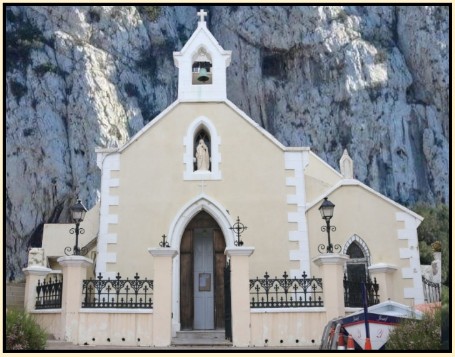
Photograph c. 2000, edited to remove modern structures.
The Census of 1878
On Census Day, April 1878, Catalan Bay had 291 residents living in 24 residential structures (including 2 huts). All but 34 were native-born Gibraltarians. Of the aliens, 18 were seasonal fisherman, 7 were resident on temporary permits, and 9 were alien wives and widows of Gibraltarians. All inhabitants professed the Roman Catholic faith. Excluding the seasonal fishermen, 41 of the males were married or widowers; 49 of the females were married or widows. Employment status and age distribution were enumerated as follows:
Boatmen & Fishermen | 86 |
Domestic Servants, Seamstresses, Laundresses | 28 |
Artizans & Tradesmen | 11 |
Clerks | 10 |
Labourers | 8 |
Goatherds | 1 |
Unemployed | 2 |
Housewives & Widows | 62 |
Children | 83 |
Note that of the employed boys and men, 74.1% were boatmen or fishermen.
Age Distribution
<10 | 10-19 | 20-39 | 40-59 | 60+ | |
| Catalan Bay, Number | 74 | 64 | 77 | 49 | 27 |
| Catalan Bay, Percent | 25.3 | 21.9 | 26.4 | 16.8 | 9.3 |
| Town & Territory Percent | 23.0 | 20.2 | 32.9 | 18.5 | 5.4 |
Age distribution for the entire civil population excludes 1,135 aliens present on temporary permits. It includes "permanent" resident aliens (holders of 1st and 2nd Class residency permits). Of the temporary resident aliens, 46% were age 20 to 39.
Note that there were relatively far more older people in Catalan Bay than in the colony as a whole. Life expectancy in the isolated fishing community was probably greater than for the rest of the colony due to the more sanitary environment and a fish-based diet.
Links to Other Websites
Note: The webpages will open in new windows.
Click on the link to go to that page of the website. Click on the icon to go to the website's home page.
The above link is to an essay on the website of The People of Gibraltar which is maintained by Neville Chipulina.
The above link is to an essay on the website of The People of Gibraltar which is maintained by Neville Chipulina.
The link is to a 19th Century, stereoscope photograph of the small barracks at Catalan Bay. From the George Washington Wilson collection of the University of Aberdeen. Click on the icon to the right for the home page of the university's libraries and museums.
[ You are at www.majortweedy.com>Molly's Gibraltar>Catalan Bay ]
